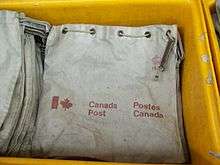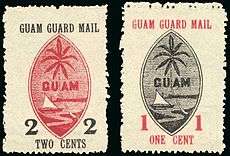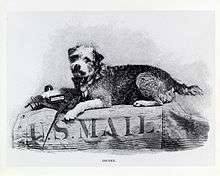Mail pouch
A mail pouch or mailpouch is a container for mail, designed to transport first-class, registered mail, domestic mail and military mail.[1] It usually has a drawstring, and is made of a stronger material (e.g., canvas) than mail sacks (e.g., plastic) and is designed to lock at the top with a mechanism system consisting of special closely spaced eyelets and a strong strap to secure the top where access into the bag is closed off and locked, where a mail sack does not have these features.[2]


Etymology and word origins
- According to the Online Etymology Dictionary mail is 12th century for letters or post. The meaning was further extended to "letters and parcels" in the 18th century by way of "bag full of letters" (1650s) or "person or vehicle who carries postal matter" (1650s). The Online Etymology Dictionary says that in 19th century England, "mail" was interpreted as letters going abroad and local communications was defined as "post".[3]
- According to the Online Etymology Dictionary pouch is late 14th century for "small bag in which money is carried", from Anglo-French puche, of 13th century Old French pouche and poche. It has a root Germanic basis and Old English pocca meaning "bag", which is a derivative from cavities in animal bodies.[4]
- According to The Free Dictionary by Farlex the word term "mail pouch" or "mailpouch" means pouch used in the shipment of mail. It has basically the same meaning as "mailbag" – which originated 1805–1815.[5][6]
U.S. Postal Service
First-class mail
In U.S. Postal Service (USPS) usage, first-class mail that would be carried in a mail pouch is mail sealed against postal inspection. An example of first-class mail is a typed letter or one written by hand. It must weigh less than 13 ounces.[7]
Registered mail
Registered mail that would be carried in a mail pouch is mail that is within a certain length and width, regardless of thickness. Registered mail can be insured up to $25,000 for a certain premium fee. There is no limit on the value of an item sent in by registered mail. Registered mail is closely guarded and given maximum security— like in handling with a locked mail pouch.[7]

Military mail
Military mail that would be carried in a mail pouch is mail ultimately handled by the Military Postal Service (MPS), which is an extension of the United States Postal Service. Many times it is mail provided outside of the contiguous United States.[8]
Domestic mail

Domestic mail that would be carried in a mail pouch is mail that would be ultimately delivered to United States territories and possessions (e.g., Army Post Offices (APOs), fleet Post Offices (FPOs), and the United Nations, NY). The United States Postal Service defines "territories and possessions" in its Domestic Mail Manual (DMM) as being American Samoa, Manua Island, Swains Island, Tutuila Island, Guam, Northern Mariana Islands, Commonwealth of the Rota Island, Saipan Island, Tinian Island, Puerto Rico, U.S. Virgin Islands, St. Croix Island, St. John Island, St. Thomas Island, Wake Atoll, and Wake Island. Mail originating in the United States and going to or coming from the Freely Associated States is treated as domestic mail. These are the Marshall Islands, Ebeye Island, Kwajalein Island, Micronesia, Kosrae Island, Pohnpei Island, Yap Island, Palau, and Koror Island.[9]
Diplomatic pouches
Diplomatic pouches are outside the control of the U.S. Mail. Thus, once a package is delivered to the U.S. State Department for inclusion in a Diplomatic pouch, the Postal Service considers it to have been delivered to the addressee, who then has the risks and responsibilities for its care and contents.[10]
U.S. traveling postal service
Closed-pouch and express-pouch service
According to a 1903 U.S. government report there was also a closed-pouch and express-pouch service associated with the U.S. traveling mail service. The report says that the number of clerks traveling in cars and boats was 10,555 and they traveled 235,114,604 miles. When added the closed-pouch and express-pouch service, the total number of miles traveled by clerks was 344,892,127.[11]

Through-registered pouches
"Through-registered pouches" are used in "through-registered service" of registered mail between post offices where hand-to-hand receipts can be obtained through the entire mail route of a Railway Post Office.[12] Only certain Post Offices are designated "through-registered-pouch-offices".[13] These pouches handle registered mail and have locked inner sacks within them.[14]
"Through-registered pouches" were not only made of canvas, but had several thick staples at the top where a long leather strap passed through and locked for extra security.[15] These pouches that transported registered mail between large cities were made with leather bottoms for extra strength.[16]
Other mail pouch systems
Private mailbag
Some countries use a so-called Private Mail Bag (also known as a "locked bag") which addresses a worldwide need for specialized mail delivery to single location, and are used for delivery to particular customers, such as corporations or governmental agencies. This is in lieu of a Post Office Box.[17] Some locked bag customers have individualized corporate postal codes.[upper-alpha 1] Like PO Box addresses, Private Mail Bag addresses omit the name of the building and street, and include only the number allocated to the user.[17] Private Mail Bag addresses are often used in countries in Africa where there may be no street delivery service. In Europe and North America, where street delivery is more commonplace, large users may be allocated their own postal codes, and consequently need only use their physical address in correspondence; the postal code implies that the recipient receives mail by caller service. See M-bags, also called "Direct Sacks", which are large bags used for surface based shipment of large or heavy items to a single address.
Mailbags are considered to be part of the postal system and are protected by law; interference with them can be the subject of criminal prosecution.[18]
Mail pouches in popular culture
The form of the bag inspired the form and container of the West Virginia Mail Pouch Tobacco, which was featured on the ubiquitous Mail Pouch Tobacco Barn. This barn advertisement was created for the Block Brothers Tobacco Company. About 20,000 Mail Pouch barns spread across 22 states in the 1960s.[19] The advertisements were popular enough to have fostered spin off mementos and memorabilia, including a Mail Pouch thermometer.[20]
See also
Bibliography
Footnotes
- For example, the Washington Post has the unique ZIP code 20071.
References
- Marsh, Allison (March 2006). "Prototype Mail Pouch". Former Object of the Month. National Postal Museum, Smithsonian Institution. Retrieved August 15, 2012.
- Melius p. 40
- "Definition of "mail" (n.1)". Online Etymology Dictionary. 2012.
- "Definition of "pouch"". Online Etymology Dictionary. 2012.
- "Definition of "mail pouch"". The Free Dictionary. 2012.
- "mailbag or mailsack or mailpouch". Collins English Dictionary - Complete & Unabridged 11th Edition. Retrieved October 25, 2012 from CollinsDictionary.com.
- Division of the Federal Register, United States. Federal Register Division, United States. Office of the Federal Register, U.S. Government Printing Office, 1984, pp. 312-339. (Google eBook)
- "14 FAM 750 Military Postal Service" (pdf). U.S. Department of State Foreign Affairs Manual. U.S. Department of State. 14 (Logistics Management): 750. Retrieved December 13, 2015.
- "Domestic 608 Postal Information and Resources, Mail Manual". United States Postal Service. Retrieved August 16, 2012.
- "14 FAM 720 Diplomatic Pouch Policy" (PDF). U.S. Department of State Foreign Affairs Manual. U.S. Department of State. 14—Logistics Management: 1 of 29. Retrieved December 13, 2015.
- United States Post Office Dept (1903). Annual report of the Postmaster General. U. S. Government Printing Office. p. 141. Retrieved September 23, 2012.
- United States official postal guide. United States. Post Office Department. 1906. p. 873. Retrieved August 21, 2012.
- Bissell, Thomas H. (1879). The postal laws and regulations of the United States of America: published in accordance with the Act of Congress. United States Post Office. Retrieved August 21, 2012.
- Cohen, Amy. "Mail pouch". Moving & Sorting Equipment. Smithsonian Institution. National Postal Museum. Retrieved August 21, 2012.
- "Through-registered pouch". Arago Researcher Program Style Guide for Researchers and Editors. Smithsonian Institution. Archived from the original on December 9, 2012. Retrieved September 23, 2012.
- Cushing, Marshall (1893). The Story of Our Post Office: The Greatest Government Department in all its Phases. Boston, Massachusetts: A. M. Thayer & Co. Retrieved September 23, 2012 – via Internet Archive.
- "Locked bags". Australia Post. Retrieved October 13, 2012.
- Alkhatib, Shaffiq (21 June 2010). "Man pleads guilty to stuffing rubbish, faeces into SingPost letterbox". Singapore: Singapore News. Retrieved 23 September 2012.
- Gilbert Brown, Carole (July 24, 2008). "Demolition uncovers Mail Pouch ad". Pittsburgh Post-Gazette. Retrieved August 17, 2012.
- "Mail pouch Tobacco Thermometer". Collectors Weekly. Retrieved September 2, 2012.
Sources
- Melius, Louis (1917). The American postal service: history of the postal service from the earliest times. The American system described with full details of operation. Washington, D.C.: National Capital Press. Retrieved August 15, 2012 – via Internet Archive.
Further reading
- Cushing, Marshall (1893). The Story of Our Post Office: The Greatest Government Department in all its Phases. Boston, Massachusetts: A.M. Thayer & Co – via Internet Archive.
External links
| Wikimedia Commons has media related to mail bags. |
- Mail pouch description at the Smithsonian National Postal Museum.